Stop. The. Presses. I won on Alpe Du Zwift!
If you are going to win your first race on Zwift, you might as well win big – but sadly it wasn’t a moment where I crossed the finish line with my arms aloft, celebrating. And I think it’s something Zwift needs to try and address! But more on that later…
The Haute Route Watopia and riding into form
The previous week, I battled the three stages of Haute Route Watopia 2021. I think the courses were fun, challenging, and different. Unfortunately, the entire event was let down by the failure of the “General Category” competition not functioning properly on ZwiftPower.
I never got to the bottom of the issue and despite repeated requests for an interview, Zwift did not respond. The event ultimately left many racers, myself included, very frustrated by the failure of the ‘GC competition’. By the time the results were published a week later, I, like many, had moved on with life and didn’t really care. The whole experience, which was badged as a “GC competition” disintegrated into a farce as you never knew where you were in the competition – it was like racing the Tour de France and no one knowing where they were in the standings until the final results were published, a week after the finish.
It just failed, and this issue with results would resurface later. That said, after racing Haute Route and coming into a bit of form, I decided to have an easy week, recover, and target a quick time up the Alpe Du Zwift.
Target the Mountain
My chosen event was the Road to Sky race by Team3R on Sunday morning (CET). My aim was to try and crack the Alpe in under 40 minutes. I agree, it is an insane target. But in January 2021 I managed to climb the Alpe in 40 minutes and 05 seconds, and was heartbroken afterward when I was told by a fellow competitor that the Canyon Aeroad which I had ridden was no longer the fastest climbing bike in the game and had probably cost me 9 seconds over the Specialized Tarmac Pro. I clearly had missed the memo where Zwift had downgraded its performance stats!
6 seconds haunted me. I had tried several times to recreate the magic of that climbing performance and break the 40 minute barrier, but it proved elusive. I was always a minute or two off and thus I concluded that the time of 40.05 was merely a fluke and had come off the back of the Rapha 500, which I had completed over the Christmas period.
Race preparation
Not to repeat the same mistake in terms of bike choice, I grabbed the Specialized Tarmac Pro and the Lightweight Meilenstein wheels (which I had gained in a previous failed attempt up the Alpe). This was the quickest ‘climbing setup’ according to the stats.
I skipped racing in week leading up, instead undertaking several easy rides with the intention of keeping my legs fresh. Wanting to save every ounce of energy, I did an easy, short, 6km warm-up, then it was off to the start.
The Start
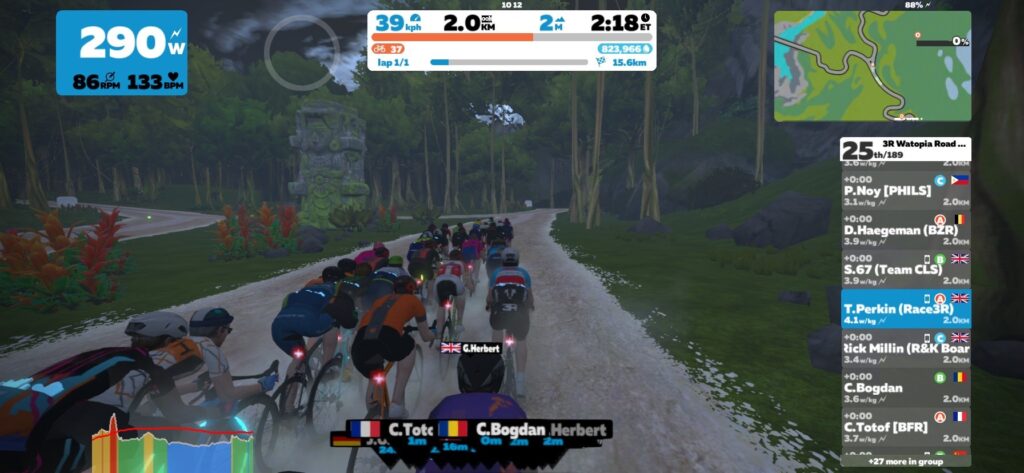
Conscious to conserve all my energy for the climb, I made sure at the start of the race that I immediately got in the middle of the bunch. I didn’t want to be pushing to catch the front of the group so I did just enough to keep within the group as we sped through the Jungle. I noted that the event was well attended with 189 riders, with over 30 in Category A, which I was racing.
We navigated the Jungle, and hit the base of the climb. Then the group exploded.
The First Turn
There is a danger when racing the Alpe that you go too hard on the early slopes then fade away toward the end or worse, completely blow up. The difficulty is that if you go too easy at the start, then your chance of a good time can disappear.
My strategy was to hit the first turn hard and settle into a sustainable rhythm as soon as possible. Two riders pulled away, but I let them go, focusing on my own pacing. I was racing the clock and had decided not to get drawn into racing the people.
I hit the first turn and the Head-Up-Display on the left of the screen noted that I had churned out a massive 360 watts. This was above what I was capable of, and since I knew it was unsustainable, I dropped a gear and began spinning my legs. My usual low cadence of 70 jumped to 80-90 rpm.
During a recent Wednesday “Andy’s Schleck’s Cappuccino Ride”, the Tour de France winner provided some valuable insight into climbing quickly. He said, “to climb quickly, it is best to use an easy gear and have a high cadence and ‘spin the legs’ as this avoids fatiguing the muscles.” I tried to adopt this approach, figuring if I could get anything above my usual 65 rpm that would benefit me.
The early slopes
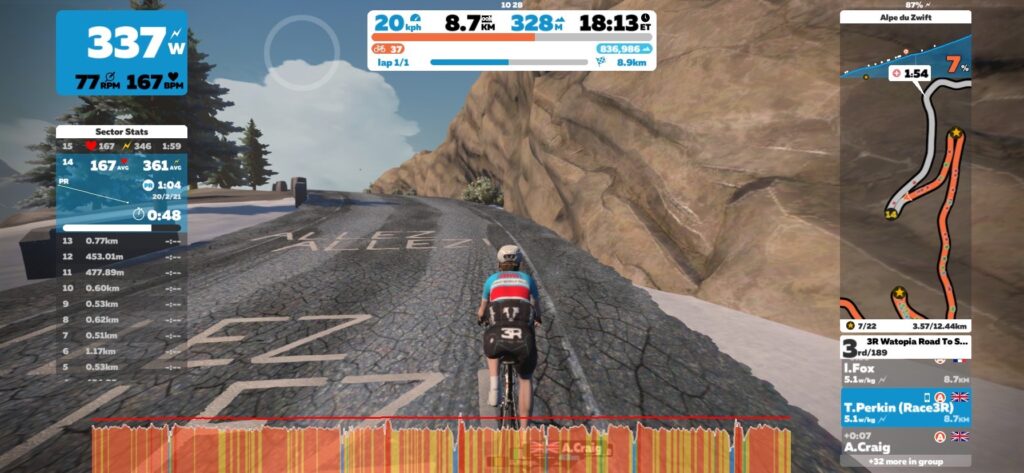
The Alpe is a long way. I always appreciate the distance climbed but only on the descent because on the way up, I’m too focused on getting to each corner. To that end, the early slopes were a blur, I tried to keep my heart rate below the “red zone” whilst keeping the cadence and power high. On the approach to each turn, I was sure to change down a gear or two and really power through the corner, ensuring I have momentum to propel me forward before once again settling back into the rhythm of the climb.
Having previously failed at trying to break sub 40 minutes, I realized that even 1 second lost on each turn could be costly, so I became focused on making each turn effective. By turn 15 I was outputting around 345 watts, which I calculated might be enough for me to reach my target, if I could maintain it.
Halfway
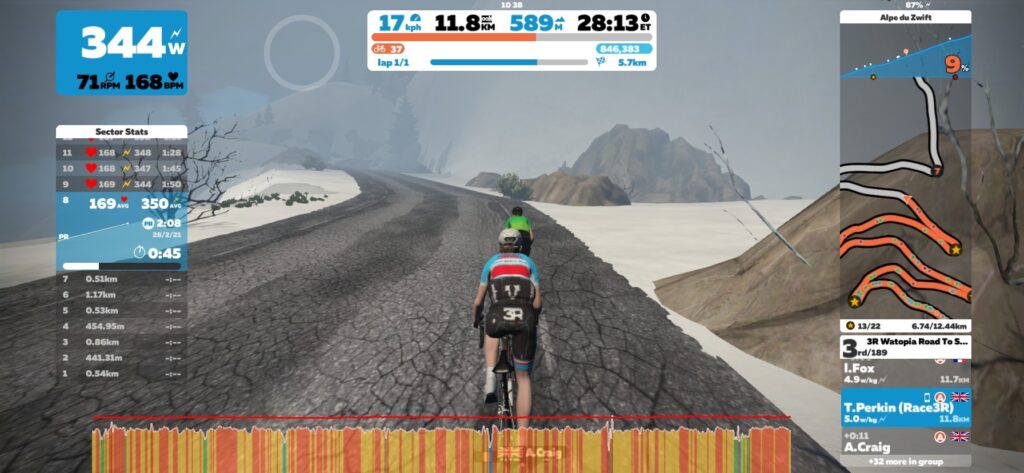
Halfway up the mountain, I was well into the rhythm of the climb. My heart rate was consistent, my power was steady, and despite being tired, I was still conscious of my surroundings as the ‘red fog’ had not yet descended. This was a good sign.
It was at this point I caught and overtook the second-placed rider on the road. He probably had reached the ‘red fog’ state I had just mentioned, and he had slowed considerably. It meant I was now sitting in second place on the road, with the lead rider some 300 meters ahead and out of sight.
At this point, I realized that I was in unchartered waters. It’s very rare to find myself at the front of a race, hence the typical title of my articles (“The View from the Back”). Yet here I was, halfway up the climb, sitting in second!
I didn’t let the prospect of a high finish stay in my thoughts too long, my target was still the sub 40 minutes and I reckoned that if I could try and manage my effort over the next few kilometers, I might be in with a chance. But it would be close. Earlier, I researched that to reach my target, I would need to be hitting over 5 watts per kilo and this was my current level.
Turn 7 and 6
The long straight stretch between turn 7 and 6 is relentless and for me probably one of the most critical and difficult parts of the race. It’s where fatigue creeps in. With roughly 4km to go, there still is a lot of climbing to be done, you are tired, and now you have to dig deep. Today was no exception.
I pushed round turn 6 but I could tell that the legs were failing. The mind was willing, but the legs couldn’t push the power like before. I could almost hear the late great commentator, Paul Sherwen, offering some sound bite like “Bridge to engine room; more power!”
The Final Turns
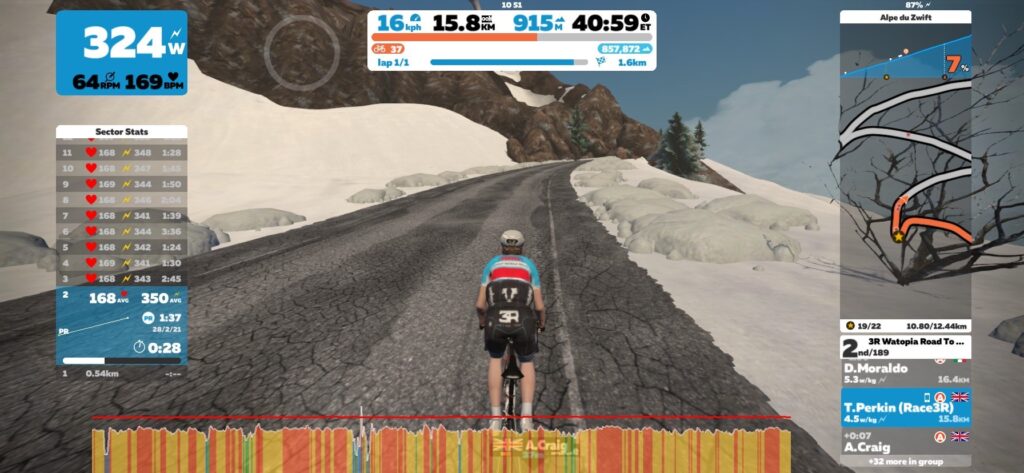
I managed to squeeze more power out of my failing legs. For the first time in the race I noted the position and time gaps to my competitors. I could see there were two riders behind me and noted that they were gaining on me. Seconds were being chipped away with each passing meter and as I rounded the last turn, I had a 7-second advantage.
I was now not only racing for my sub 40-minute target, but racing for position. By this stage, I was really hot, the fan offering little respite, so like the riders in the Tour de France, I poured the remaining water from my bidón over my head. Any little help was welcome!
The final stretch
The final push to the finish after the last corner is never ending and the ‘red fog’ I mentioned earlier had engulfed me. I pushed as hard as I could, holding over 400 watts as my heart rate rocketed as I summoned up every last reserve of energy attempting to defend my position on the road.
With 400 meters to go, I was in 2nd position. I kept pushing, but the rider behind was chasing. I could “feel him” and I saw he was putting out a staggering 6.5 watts per kilo. Through sheer panic I somehow managed 6, which at this stage even surprised me!
To force the pace I got out of the saddle to sprint, but had nothing. With 50 meters before the line, the rider sped past me. I was heartbroken.
The results
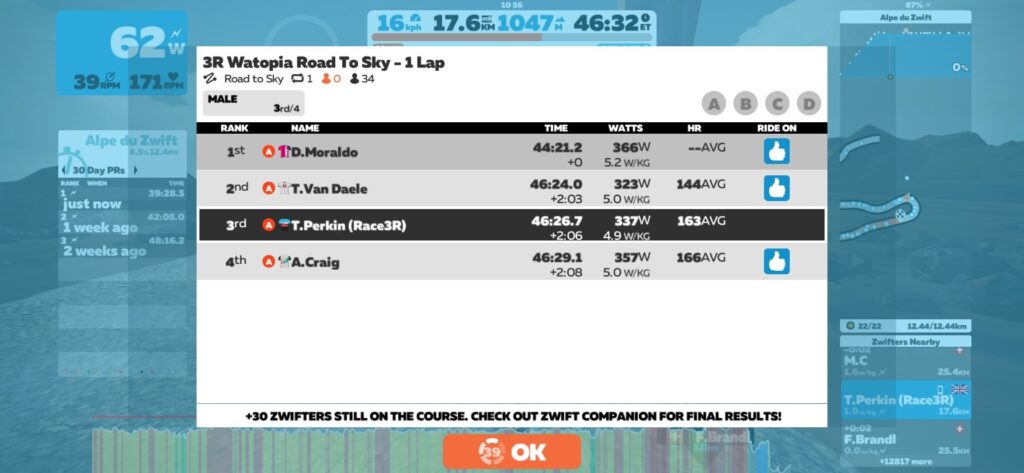
As I crossed the line, the results flashed up. The first-placed rider didn’t have a heart rate meter. I knew that his results would not count in ZwiftPower and so being overtaken on the line by the second-placed rider was extra-devastating since I had lost out on the chance of victory up the famous mountain. Or so I believed.
The consolation was that I had climbed the mountain in a staggering 39 minutes, 28 seconds. I had achieved my goal! I immediately logged on ZwiftPower to check my data. And I couldn’t believe what I saw. ZwiftPower had me in first place!
“I won!” I shouted. The second-placed rider was not on ZwiftPower meaning that I had taken victory as per the rules of the race!
Summing up

Naturally, I am pleased to have won the race and achieve my target of sub 40 minutes, but the joy was only felt well after the crossing the line. That moment of joy when crossing the finish line as per real life was not there, and checking the race results on a different system took away from the experience.
I don’t have a solution on how to correct the issue, but perhaps to enter races there needs to be prerequisites in order to partake. This is an issue for Zwift to look at and solve. And this leads me to the point I started with about the Haute Route and the ‘General Classification’ issue and Zwift Power.
If Zwift is going to host racing events, they need to look at it holistically and put in processes and procedures to ensure the user experience is enhanced. Because I want my next win to feel better than this. After all, I earned that moment of victory and want to celebrate it, even if it’s in a virtual world!
Your Thoughts
Share your comments below!

